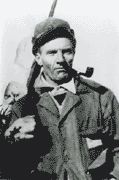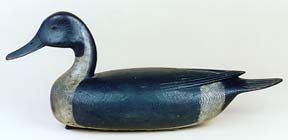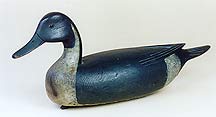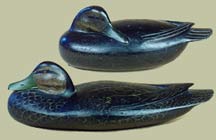by Allen Linkchorst
 Historic Burlington City, New Jersey, nestled along the banks of the Delaware River, was a hotbed of decoy making activity in the early part of this century. It was also the home of Jess Heisler, one of the River’s few commercial decoy makers and, arguably, its finest builder of duck hunting boats. Historic Burlington City, New Jersey, nestled along the banks of the Delaware River, was a hotbed of decoy making activity in the early part of this century. It was also the home of Jess Heisler, one of the River’s few commercial decoy makers and, arguably, its finest builder of duck hunting boats.
As a youngster growing up near the river, Heisler cultivated the pleasures of hunting, boating and fishing with neighborhood friends. And he maintained a life-long passion as an avid duck hunter, pigeon and trap shooter, fisherman and boater.
Many of the commercial decoy makers and boat builders of the day lived the life of a "river rat." Heisler did not. His proficiency at woodworking was so good that his products commanded premium prices. And his antique furniture restoration business was lucrative. He owned an automobile and traveled widely to pursue his sporting passions.
While it’s not known when Heisler carved his first decoy, it’s believed that he started as a teenager. It is established that he was making decoys before he left for World War I and that his decoys pre-date his boat building efforts.
 Heisler’s earliest decoys are two-piece hollow-carved, round-bodied decoys very similar to the work of John English. He is known to have made wigeons, canvasbacks and pintails in this style. These graceful, streamlined lures worked great in the shallow flats and eddys. Heisler’s earliest decoys are two-piece hollow-carved, round-bodied decoys very similar to the work of John English. He is known to have made wigeons, canvasbacks and pintails in this style. These graceful, streamlined lures worked great in the shallow flats and eddys.
Heisler’s last style of decoy was even bigger, somewhat blocky, flat-bottomed, with barge-like sides. These last decoys were made near the end of Heisler’s life; by then the river was fully dredged.
Most of Heisler’s decoys were made of red cedar bodies with pine or cedar heads. The hollow bodies were sometimes made of three pieces of laminated wood – two 2-inch slabs with a half to three-quarter inch piece in between. The three-piece body required a higher level of skill to maintain a watertight decoy.
The raised primaries on Heisler’s decoys have a sharp and distinct upswing, with the heavy undercut expertly executed with a sharp chisel. Heisler incised two longitudinal grooves in the raised wings and occasionally he denoted the speculum with an incised arc on the backs of his decoys. The tails are fan-shaped and deeply notched.
 The finely executed heads have a deep cut under the bill and carved nostrils. Few have a nail at the end of the bill. Most of his early decoys have shoe button or tack eyes, and glass eyes were used on some of the later models. But the majority of his decoys have tack eyes. The finely executed heads have a deep cut under the bill and carved nostrils. Few have a nail at the end of the bill. Most of his early decoys have shoe button or tack eyes, and glass eyes were used on some of the later models. But the majority of his decoys have tack eyes.
A few of Heisler’s early pintails had high heads, but the majority of is decoys sport low or resting heads. Most of his black ducks, the species most produced on the Delaware River, have resting heads. Heisler is also credited with carving one of the earliest Delaware River sleeping decoys, a model that only he and Bill Quinn produced.
On the bottoms of his decoys, Heisler used a rectangular lead pad for ballast. The weights on the early decoys are located in the middle; after the river was dredged, the weights were moved to the rear. The leather anchor loop was held in place by small brass brads.
It’s estimated that Heisler made 1500 to 2500 decoys throughout his lifetime. While most are black ducks, he is known to have also made mallards, pintails, wigeon, canvasbacks and scaup. His son, Edward, who owns all of his father’s patterns, has a pattern for a teal. So possibly he produced those as well. Heisler also made a special rig of ten very oversized, wide and flat (so called Rocking Horse style) black duck decoys for use on the Delaware and Chesapeake Bays. Many collectors considered these his folkiest sculptures.
 Heisler’s boats are known for their sleek, streamlined look, and many consider them to be the finest ever used on the river. He built them in a second floor shop over a garage on St. Mary St. in Burlington, just a stone’s throw from his mother’s house. The shop contained an electric drill press, a bandsaw, a sander and other expensive tools of the trade. Heisler’s boats are known for their sleek, streamlined look, and many consider them to be the finest ever used on the river. He built them in a second floor shop over a garage on St. Mary St. in Burlington, just a stone’s throw from his mother’s house. The shop contained an electric drill press, a bandsaw, a sander and other expensive tools of the trade.
Heisler produced several different types of boats – double enders, sculls and a variety of small sailing vessels. But the design of his scull boats and the high quality workmanship made it an instant classic. Made from cedar, they are similar in shape to Long Island punt boats, but its low profile, generous cockpit and tapered shape made it a dream to scull. Usually 14 feet long (although one 12-foot scull exists), they were made for use in quite shallow water and were easily poled, rowed or sculled. They held wide popularity on the river.
The golden days of waterfowling no longer exist on the Delaware River. The deepened channel and the absence of flats and potholes no longer attract the number of migrating ducks of days gone by. But thanks to the work of gifted decoy makers, who established a sporting legacy on the river, those days will never be forgotten
For the complete story, please see the March/April 2001 issue of Decoy Magazine.
Tidbits Main Index

|


